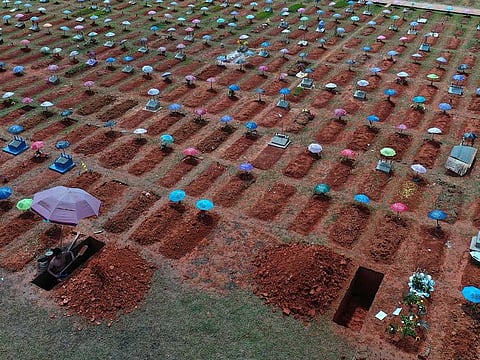Peru almost triples COVID-19 death toll
New count makes Peru one of hardest-hit nations during pandemic relative to population

Peru said that its COVID-19 death toll is almost three times as high as it had officially counted, making it one of the hardest-hit nations during the pandemic relative to its population.
In a report released Monday, which combined deaths from multiple databases and reclassified fatalities, the government said that 180,764 people died from COVID-19 through May 22, almost triple the official death toll of about 68,000. The new figure would mean that more people have died per capita in Peru than in Hungary or the Czech Republic, the countries with the highest official death tolls per person, according to a New York Times database.
The report landed at a precarious moment for Peru’s government, just days before the second round of a closely watched presidential election scheduled for Sunday.
Peru has struggled to contain the coronavirus since the pandemic began, and its official death toll before the revised estimate was already the ninth-highest per capita in the world. As early as last June, it was clear that far more deaths were occurring in Peru than would be expected in a normal year, and the gap - a figure known as excess deaths - was much larger than the number of deaths officially attributed to COVID-19, according to New York Times data. That was a warning sign to experts that COVID-19 deaths were being undercounted.
William Pan, who teaches global environmental health at Duke University, said the pandemic has underscored the deep inequality and corruption in Peru. Long before reports of oxygen shortages in India and Brazil made world headlines, COVID-19 patients were seeing similar problems in Iquitos, the largest Peruvian city in the Amazon, he said.
“Thousands of people were being turned away last April and May due to lack of oxygen, lack of space, medical staff being totally overwhelmed and more,” Pan said.
Peru could be just the first of several nations forced to reckon with a re-evaluation of the pandemic’s true impact. The World Health Organization said in May that deaths from COVID-19 globally were probably much higher than had been recorded.
Peru’s government will start publishing more accurate daily tallies of cases and deaths based on new guidelines laid out in the report, said Oscar Ugarte, the health minister.
“This is a new tool” to help us fight the pandemic, Ugarte said, adding that the new estimate “requires a modification” of all the current policies aimed at controlling the spread of the virus.
The pandemic has only intensified the political turmoil in Peru, which was rocked by the impeachment of President Martin Vizcarra in November. He was one of four presidents to serve in five years, three of whom spent time in jail during bribery investigations.
Vizcarra’s ouster led to protests and came just months before the first round of presidential elections in April. Pedro Castillo, a former union activist and teacher, won the most votes in April and will face Keiko Fujimori, the daughter of jailed former president Alberto Fujimori, on Sunday.
The virus is spreading faster in South America than on any other continent, according to official data, with five nations among the top 10 globally for new cases reported per person.
The continent’s worst outbreak is in Argentina, which was supposed to host the Copa AmErica soccer tournament, before organisers announced they were moving it to Brazil.
“Latin America has been one of the hardest-hit regions in the pandemic,” said Dr Michael H. Merson, a professor of global health at Duke University. “I suspect that other countries in the region will be revising their estimates of deaths from COVID-19.”
The spread of the virus has slowed lately in Brazil, which has been ravaged by a variant known as P.1.
Over the weekend, thousands of Brazilians critical of President Jair Bolsonaro took to the streets in the largest public mobilisation against the president since the beginning of the pandemic. Their show of force in cities across the country followed a series of damning revelations in congressional hearings examining the government’s catastrophic response to the coronavirus, which has killed more than 461,000 Brazilians.
Sign up for the Daily Briefing
Get the latest news and updates straight to your inbox








